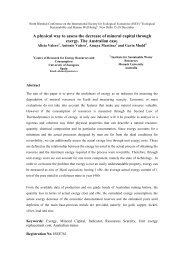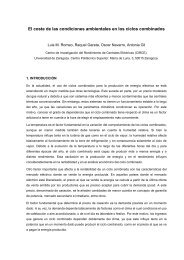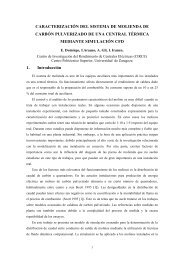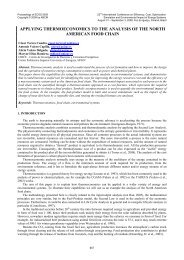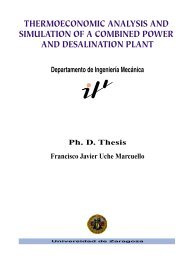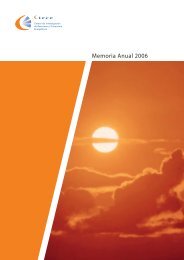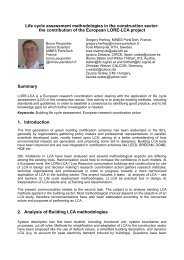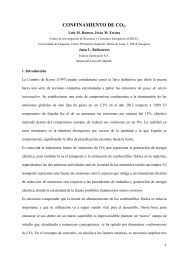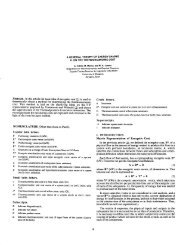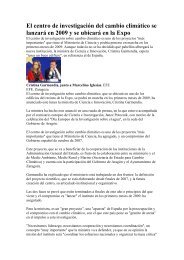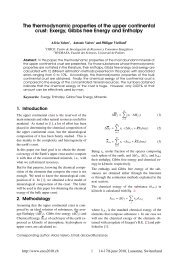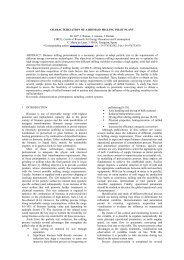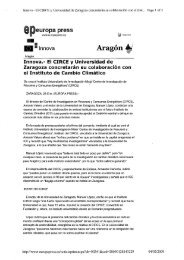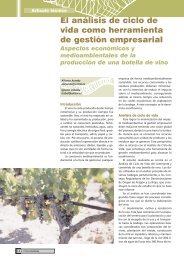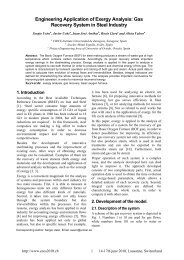Exergoeconomic Cost Evaluation based on Irreversibility ... - circe
Exergoeconomic Cost Evaluation based on Irreversibility ... - circe
Exergoeconomic Cost Evaluation based on Irreversibility ... - circe
You also want an ePaper? Increase the reach of your titles
YUMPU automatically turns print PDFs into web optimized ePapers that Google loves.
<str<strong>on</strong>g>Exergoec<strong>on</strong>omic</str<strong>on</strong>g> <str<strong>on</strong>g>Cost</str<strong>on</strong>g> <str<strong>on</strong>g>Evaluati<strong>on</strong></str<strong>on</strong>g> <str<strong>on</strong>g>based</str<strong>on</strong>g> <strong>on</strong> <strong>Irreversibility</strong><br />
Decompositi<strong>on</strong> Analysis<br />
César Torres and Ant<strong>on</strong>io Valero<br />
CIRCE. Centro de Investigación de Recursos y C<strong>on</strong>sumos Energéticos<br />
University of Zaragoza, Spain<br />
e-mail: ctorrescuadra@endesa.es<br />
ABSTRACT: The objectives of the paper are to review the c<strong>on</strong>cepts of the avoidable<br />
endogenous/exogenous part of the irreversibilities or exergy destructi<strong>on</strong> from<br />
the viewpoint of thermoec<strong>on</strong>omic diagnosis methodology and, as result of this analysis,<br />
to introduce a general technique to decompose the exergy and exergoec<strong>on</strong>omic<br />
cost into its unavoidable, endogenous and exogenous parts.<br />
The proposed method provides a detailed analysis of the cost formati<strong>on</strong> process and<br />
helps to analyze the potential improvement and local optimizati<strong>on</strong> of the system<br />
comp<strong>on</strong>ents.<br />
Keywords: <str<strong>on</strong>g>Exergoec<strong>on</strong>omic</str<strong>on</strong>g>s, <strong>Irreversibility</strong> analysis.<br />
NOMENCLATURE<br />
n Number of comp<strong>on</strong>ents<br />
E Exergy rate [kW]<br />
F Fuel exergy of a comp<strong>on</strong>ent [kW]<br />
P Product exergy of a comp<strong>on</strong>ent [kW]<br />
I <strong>Irreversibility</strong> of a comp<strong>on</strong>ent [kW]<br />
Z Investment cost rate [$/h]<br />
C <str<strong>on</strong>g>Cost</str<strong>on</strong>g> rate associated with an exergy<br />
flow [$/h]<br />
c Unit exergoec<strong>on</strong>omic cost [c/kWh]<br />
k Comp<strong>on</strong>ent unit exergy c<strong>on</strong>sumpti<strong>on</strong><br />
Matrices and Vectors<br />
ω System outputs exergy vector (n × 1)<br />
u Unity vector (n × 1)<br />
UD<br />
Identity Matrix (n × n)<br />
KD Diag<strong>on</strong>al matrix which c<strong>on</strong>tains the<br />
unit c<strong>on</strong>sumpti<strong>on</strong> of each comp<strong>on</strong>ent<br />
(n × n)<br />
〈KP〉 Unit c<strong>on</strong>sumpti<strong>on</strong> matrix (n × n)<br />
〈KP〉 Residue ratios Matrix (n × n)<br />
|P〉 Product operator matrix (n × n)<br />
|I〉 <strong>Irreversibility</strong> operator matrix (n × n)<br />
|R〉 Residue operator matrix (n × n)<br />
Greek Letters<br />
κ Unit exergy c<strong>on</strong>sumpti<strong>on</strong><br />
τ Technical exergy saving<br />
Subscripts and superscripts<br />
F Related to Fuel<br />
P Related to product<br />
e Related to external resources<br />
z Related to investment costs<br />
r Related to residues<br />
t Transpose Matrix<br />
−1 Inverse Matrix<br />
0 Reference state<br />
UN Unavoidable<br />
AV Avoidable<br />
EN Endogenous<br />
EX Exogenous<br />
Abbreviati<strong>on</strong>s<br />
MAI Maximum Avoidable <strong>Irreversibility</strong><br />
AICS Avoidable <strong>Irreversibility</strong> <str<strong>on</strong>g>Cost</str<strong>on</strong>g> Saving<br />
261
1. INTRODUCTION<br />
In practice, when attempting to achieve<br />
effective energy savings in energy systems,<br />
<strong>on</strong>ly a part of the exergy destructi<strong>on</strong> or irreversibility<br />
can be avoided by using the best<br />
current technology.<br />
Valero and co-workers [1, 2] stated in the<br />
early 80’s that for any decisi<strong>on</strong> level of an energy<br />
system: operati<strong>on</strong>, maintenance, design<br />
or synthesis, there exists a relati<strong>on</strong>ship called<br />
Law of Saving-Investment which relates the<br />
potential energy saving ∆I and its required<br />
investment ∆Z following a saturati<strong>on</strong> curve<br />
of the type:<br />
∆I = τ 1 − exp(−ε∆Z) <br />
(1)<br />
This equati<strong>on</strong> notes two important facts.<br />
First, the existence of an energy saving limit<br />
for each level of decisi<strong>on</strong>, called Technical<br />
exergy saving [4] and represented by τ,<br />
which is defined as the maximum irreversibility<br />
that it is possible to save relating to a<br />
reference c<strong>on</strong>diti<strong>on</strong> defined by the decisi<strong>on</strong><br />
level. And sec<strong>on</strong>d, a saturati<strong>on</strong> trend given<br />
by the elasticity parameter ε.<br />
Independently, Tsatar<strong>on</strong>is and coworkers<br />
[3] also states that the exergy destructi<strong>on</strong><br />
of an energy system comp<strong>on</strong>ent can be decomposed<br />
into its avoidable and unavoidable<br />
parts:<br />
I = I UN + I AV<br />
(2)<br />
In an energy analysis, the avoidable irreversibility<br />
IAV gives a realistic picture of the<br />
potential for improving the thermodynamic<br />
effectiveness of each comp<strong>on</strong>ent. The unavoidable<br />
irreversibility IUN cannot be reduced<br />
due to technological limitati<strong>on</strong>s (e.g.<br />
availability and cost of materials and manufacturing<br />
methods)<br />
Theoretically, the investment cost per producti<strong>on</strong><br />
unit could be expressed as functi<strong>on</strong><br />
of the unit c<strong>on</strong>sumpti<strong>on</strong> k:<br />
α k<br />
Z = Z0 + β P<br />
k − k0<br />
γ<br />
262<br />
where k0 is the unit c<strong>on</strong>sumpti<strong>on</strong> at an avoidable<br />
state x0, such as the investment cost Z<br />
of a system comp<strong>on</strong>ent verifies:<br />
lim Z(k) = ∞<br />
k→k0<br />
this state is called Maximum Avoidable <strong>Irreversibility</strong><br />
(MAI) state. In practical applicati<strong>on</strong>s,<br />
the MAI state could be determined by<br />
selecting the most important thermodynamic<br />
parameters to obtain its maximum avoided<br />
irreversibility per producti<strong>on</strong> unit, such a<br />
comp<strong>on</strong>ent will have a very large investment<br />
cost.<br />
Then, the avoidable exergy destructi<strong>on</strong><br />
could be c<strong>on</strong>sidered as a particular instance<br />
of the more general c<strong>on</strong>cept of technical exergy<br />
saving applied to the design level. The<br />
avoidable irreversibility is the difference between<br />
the current and the MAI state, and applying<br />
eq. (1), we get:<br />
I AV = ∆I = τ (3)<br />
The technical exergy saving is the base<br />
idea of the thermoec<strong>on</strong>omic diagnosis<br />
methodology [5], developed by Valero and<br />
co-workers from the beginning of the 90’s<br />
and formerly called Perturbati<strong>on</strong>s Theory<br />
[6]. Thermoec<strong>on</strong>omic diagnosis [7]<br />
states that the variati<strong>on</strong> of the irreversibility<br />
respect to a reference state {x 0 } could be<br />
decomposing into two parts:<br />
∆I = P(x 0 ) ∆k + k(x) ∆P (4)<br />
The first term represents the malfuncti<strong>on</strong><br />
or endogenous irreversibility due to the<br />
degradati<strong>on</strong> of its efficiency regarding to a<br />
reference state and the sec<strong>on</strong>d term represents<br />
the irreversibility variati<strong>on</strong> caused by<br />
the producti<strong>on</strong> c<strong>on</strong>diti<strong>on</strong>s, which origin are<br />
the inefficiencies of the remaining comp<strong>on</strong>ents<br />
of the system, called dysfuncti<strong>on</strong> or exogenous<br />
irreversibilities.<br />
The Advanced exergoec<strong>on</strong>omic evaluati<strong>on</strong><br />
(AEE) [8, 9] applies these c<strong>on</strong>cepts to<br />
the evaluati<strong>on</strong> of thermal system cost effectiveness,<br />
<str<strong>on</strong>g>based</str<strong>on</strong>g> <strong>on</strong> exergy destructi<strong>on</strong> decompositi<strong>on</strong><br />
analysis. The avoidable part of<br />
the exergy destructi<strong>on</strong> could be decomposed<br />
into the endogenous part of the exergy destructi<strong>on</strong><br />
in a system comp<strong>on</strong>ent I EN , which
is associated <strong>on</strong>ly with the irreversibilities<br />
occurring in the comp<strong>on</strong>ent when all other<br />
comp<strong>on</strong>ents operate in an ideal way, and the<br />
exogenous part of the exergy destructi<strong>on</strong> I EX<br />
caused in the comp<strong>on</strong>ent by the irreversibilities<br />
that occur in the remaining comp<strong>on</strong>ents,<br />
therefore:<br />
I AV = I EN + I EX<br />
(5)<br />
The noti<strong>on</strong> of ideal or theoretical system<br />
is associated with the MAI state. The<br />
method is applied to refrigerati<strong>on</strong> cycles,<br />
which defines a theoretical and a real system<br />
and compare them.<br />
Therefore, the aim of this paper is to analyze<br />
the AEE methodology from the perspective<br />
of the Thermoec<strong>on</strong>omic Diagnosis<br />
in order to clarify these c<strong>on</strong>cepts and to<br />
take advantage of the c<strong>on</strong>tributi<strong>on</strong>s of both<br />
methodologies to improve them and to integrate<br />
into a more general theory of energy<br />
saving, which fundamentals are exposed in<br />
ref. [2].<br />
7<br />
8 9<br />
1<br />
5<br />
HRSG<br />
2<br />
6<br />
Air<br />
Preheater<br />
4<br />
12<br />
2<br />
Combusti<strong>on</strong><br />
Chamber<br />
11<br />
3<br />
Air<br />
Gas<br />
Compressor<br />
Turbine<br />
Figure 1: Flow Diagram of CGAM System.<br />
The well-known CGAM problem [10] is<br />
used to illustrate the theoretical results. It is a<br />
cogenerati<strong>on</strong> plant, which purpose is to generate<br />
a net electric power of 30 MW and to<br />
provide saturated steam at 20 bar. It c<strong>on</strong>sists<br />
of a gas turbine system and a heat recovery<br />
steam generator. The flow diagram of the<br />
plant is depicted in Fig. 1. The productive<br />
structure and the corresp<strong>on</strong>ding exergy flow<br />
values are shown in Fig. 2.<br />
The MAI state definiti<strong>on</strong> of the problem is<br />
made according reference [3]. Table I shows<br />
1<br />
3<br />
5<br />
4<br />
10<br />
the values of the system parameters applied<br />
to the current and the MAI state. The thermoec<strong>on</strong>omic<br />
model, which is <str<strong>on</strong>g>based</str<strong>on</strong>g> <strong>on</strong> EES<br />
and TAESS, used to make the calculati<strong>on</strong><br />
could be found in reference [11].<br />
Table I: CGAM Parameters.<br />
Parameter MAI state CUR state<br />
∆Pcc 0.005 0.05<br />
ηAC 0.9 0.84<br />
ηGT 0.92 0.88<br />
ηAP 0.98 0.82<br />
T4 [ o C] 1300 1200<br />
∆TP [ o C] 2 8<br />
m9 [kg/s] 13.83 7.90<br />
2. COST DECOMPOSITION<br />
Symbolic <str<strong>on</strong>g>Exergoec<strong>on</strong>omic</str<strong>on</strong>g>s [12] allows<br />
relating the producti<strong>on</strong> and other thermoec<strong>on</strong>omic<br />
variables of the plant as a functi<strong>on</strong><br />
of the efficiency of each comp<strong>on</strong>ent and the<br />
system outputs, by means of the producti<strong>on</strong><br />
operator 1 :<br />
|P〉 ≡ (UD − 〈KP〉) −1<br />
(6)<br />
where 〈KP〉 is the unit c<strong>on</strong>sumpti<strong>on</strong> matrix<br />
which elements are defined as κi j ≡ Ei j/P j.<br />
According to ref. [13] is possible to decompose<br />
the unit producti<strong>on</strong> cost into three<br />
types of c<strong>on</strong>tributi<strong>on</strong>s:<br />
cP = c e P<br />
+ cz<br />
P + cr P<br />
(7)<br />
The c<strong>on</strong>tributi<strong>on</strong> caused by external fuel resources:<br />
t e<br />
cP ≡ t |P〉 κe<br />
(8)<br />
where κe,i = C0,i/Pi is the cost of the external<br />
resources c<strong>on</strong>sumed in a comp<strong>on</strong>ent per<br />
producti<strong>on</strong> unit.<br />
The c<strong>on</strong>tributi<strong>on</strong> due to the investment<br />
and maintenance cost of the equipment is:<br />
t z<br />
cP ≡ t |P〉 zP<br />
(9)<br />
where zP,i = Zi/Pi is the equipment cost per<br />
producti<strong>on</strong> unit.<br />
1 It is equivalent, in terms of the ec<strong>on</strong>omic Input-<br />
Output theory, to the Le<strong>on</strong>tief inverse matrix.<br />
263
E12<br />
1<br />
E1<br />
E4 − E3<br />
Air-Gases<br />
E2 − E1<br />
E5 − E4<br />
E3 − E2<br />
E5 − E6<br />
E6 − E7<br />
E7<br />
2<br />
3<br />
4<br />
5<br />
E11<br />
E10 + E11<br />
E9 − E8<br />
Work<br />
E10<br />
E9<br />
E8<br />
Water-Steam<br />
Flow# MAI state CUR state<br />
1 0.0 0.0<br />
2 20321.0 28151.3<br />
3 39681.5 46824.8<br />
4 84735.8 103406.5<br />
5 31921.6 40161.2<br />
6 11295.9 19277.5<br />
7 1939.5 2095.7<br />
8 0.0 0.0<br />
9 6968.2 12427.1<br />
10 30000.0 30000.0<br />
11 21455.2 30591.5<br />
12 63405.1 82073.4<br />
Figure 2: Flow Exergies [KW] and Fuel Product Diagram of CGAM System.<br />
Finally, the producti<strong>on</strong> cost due to the<br />
residues could be computed as:<br />
c r t |R〉<br />
P =<br />
UD − t <br />
e<br />
cP + c<br />
|R〉<br />
z<br />
<br />
P (10)<br />
where |R〉 ≡ 〈KR〉 |P〉 is the residue operator,<br />
introduced in [14].<br />
In the case of a sequential system where<br />
the product of a process is the fuel of the next<br />
<strong>on</strong>e, the product exergy cost of the i–th process<br />
is equal to its exergy plus the sum of all<br />
irreversibilities of the processes required to<br />
obtain it. This fact could be generalized to<br />
any system no matter how complex is, see<br />
ref. [15], by mean of the equati<strong>on</strong>:<br />
P ∗ n<br />
i = Pi +<br />
264<br />
j=1<br />
πi j I j<br />
where πi j are the exergy cost distributi<strong>on</strong> ratios.<br />
This equati<strong>on</strong> could be written in terms<br />
of unit exergy cost as:<br />
k ∗ P,i = 1 +<br />
n<br />
j=1<br />
φ ji<br />
where φ jiPi = πi jI j, and could be written in<br />
matrix format as:<br />
t k ∗ P = t u (UD + |I〉) (11)<br />
where |I〉 ≡ (KD − UD) |P〉 is the irreversibility<br />
operator, that satisfies:<br />
I = |I〉 ω (12)<br />
If there is <strong>on</strong>ly <strong>on</strong>e external fuel with a<br />
known unit price ce the exergoec<strong>on</strong>omic cost<br />
is simply cP,i = ce · k∗ P,i . Moreover, equa-<br />
ti<strong>on</strong> (11) could be extended to compute the<br />
exergoec<strong>on</strong>omic cost for a general case, with<br />
several external flows, by means of the equati<strong>on</strong>:<br />
t cP = t c ∗ e (UD + |I〉) (13)<br />
where c ∗ e represents the unit price of the external<br />
resources that are used for each comp<strong>on</strong>ent,<br />
and it is evaluated as:<br />
(UD − 〈PF〉) c ∗ e = ce<br />
(14)<br />
where 〈PF〉 is the juncti<strong>on</strong> ratios matrix,<br />
see [16], which elements are qi j ≡ Ei j/F j<br />
and satisfy the relati<strong>on</strong>ship:<br />
κi j = qi j ki<br />
(15)<br />
The cost decompositi<strong>on</strong>, according to<br />
eqs. (7) and (13), is illustrated in Figure 4.<br />
It shows how the unit producti<strong>on</strong> cost of<br />
the CGAM comp<strong>on</strong>ents is decomposed into<br />
their different c<strong>on</strong>tributi<strong>on</strong>s: fuel price, investment<br />
and residues costs, and the irreversibilities<br />
costs. It also proves that the<br />
main c<strong>on</strong>tributi<strong>on</strong>s are the irreversibilities<br />
<strong>on</strong> the combusti<strong>on</strong> chamber and the HRSG.<br />
These results will be reviewed later.
The parameter c ∗ e plays an important role,<br />
not <strong>on</strong>ly to generalize the irreversibility cost<br />
relati<strong>on</strong>ship, but also to determine the price<br />
of the external resources used in each comp<strong>on</strong>ent<br />
and to find alternatives to reduce it.<br />
3. IRREVERSIBILITY<br />
DECOMPOSITION<br />
Now, the questi<strong>on</strong> is to evaluate how<br />
much irreversibility could be saving if the<br />
system is moving from the current state to<br />
the MAI state, and how much it does cost.<br />
P<br />
P0<br />
I UN<br />
I EX<br />
MAI State<br />
I EN<br />
1 k0 k<br />
<br />
CUR State<br />
<br />
Figure 3: <strong>Irreversibility</strong> decompositi<strong>on</strong>.<br />
According to the ideas discussed in previous<br />
secti<strong>on</strong>, the irreversibility of each system<br />
comp<strong>on</strong>ent could be decomposed into<br />
its unavoidable and avoidable irreversibility<br />
and moreover its avoidable part could be decomposed<br />
into its endogenous and exogenous<br />
parts, <strong>on</strong> the following way:<br />
I = (k 0 − 1)P 0 + (k − k 0 )P<br />
+ (k 0 − 1)∆P<br />
(16)<br />
where k 0 and P 0 are the unit c<strong>on</strong>sumpti<strong>on</strong><br />
and producti<strong>on</strong> in the MAI state, meanwhile<br />
k and P represents these values in the current<br />
state. The first term, denoted as I UN , represents<br />
the unavoidable irreversibility. The<br />
sec<strong>on</strong>d term I EN represents the avoidable<br />
endogenous irreversibility and the last term<br />
I EX is the avoidable exogenous irreversibility.<br />
Figure 3 shows graphically this decompositi<strong>on</strong>.<br />
Using Symbolic <str<strong>on</strong>g>Exergoec<strong>on</strong>omic</str<strong>on</strong>g> notati<strong>on</strong><br />
the unavoidable irreversibility could be<br />
written as a functi<strong>on</strong> of the producti<strong>on</strong> demand<br />
at the MAI state as:<br />
I UN = |I〉 UN ω 0 where<br />
|I〉 UN ≡ K 0<br />
<br />
UN<br />
D − UD |P〉<br />
the avoidable irreversibility as:<br />
I EN = |I〉 EN ω 0 where<br />
|I〉 EN ≡ KD − K 0<br />
<br />
UN<br />
D |P〉<br />
(17)<br />
(18)<br />
and the exogenous irreversibility that also<br />
depends <strong>on</strong> the system output variati<strong>on</strong>:<br />
I EX = |I〉 EX ω 0 + |I〉 ∆ω where<br />
|I〉 EX ≡ |I〉 ∆ 〈KP〉 |P〉 UN<br />
(19)<br />
Therefore the total irreversibility of each<br />
comp<strong>on</strong>ent verifies:<br />
and<br />
I = I UN + I EN + I EX<br />
|I〉 = |I〉 UN + |I〉 EN + |I〉 EX<br />
(20)<br />
(21)<br />
Table II shows the decompositi<strong>on</strong> of the irreversibilities<br />
of each comp<strong>on</strong>ent into their<br />
parts. In case of the combustor chamber the<br />
endogenous irreversibilities are lower than<br />
10%, meanwhile the air-preheater represents<br />
near 50%.<br />
Table II: <strong>Irreversibility</strong> Decompositi<strong>on</strong> for<br />
CGAM system [kW].<br />
Device I I UN I EN I EX<br />
CC 25492 18351 1947 5193<br />
AC 2440 1134 627 679<br />
GT 2654 1359 895 400<br />
APH 2210 1265 1026 -81<br />
HRSG 4755 2388 278 2089<br />
Total 37551 24497 4773 8280<br />
In the same way that the malfuncti<strong>on</strong> locati<strong>on</strong><br />
is the key for thermoec<strong>on</strong>omic diagnosis,<br />
the endogenous exergy destructi<strong>on</strong> is<br />
the appropriate measure to locate the potential<br />
improvement of the system comp<strong>on</strong>ents,<br />
instead of the total irreversibility.<br />
265
266<br />
CC<br />
AC<br />
GT<br />
AP<br />
HRSG<br />
STK<br />
CC<br />
AC<br />
GT<br />
AP<br />
HRSG<br />
STK<br />
0 0.5 1.0 1.5 2.0 2.5 3.0 3.5 4.0 4.5<br />
<str<strong>on</strong>g>Cost</str<strong>on</strong>g> [c/kWh]<br />
Figure 4: <str<strong>on</strong>g>Cost</str<strong>on</strong>g> decompositi<strong>on</strong> of CGAM System.<br />
0 0.5 1.0 1.5 2.0 2.5 3.0 3.5 4.0 4.5<br />
<str<strong>on</strong>g>Cost</str<strong>on</strong>g> [c/kWh]<br />
Figure 5: Avoidable/Unavoidable cost decompositi<strong>on</strong> of CGAM System.<br />
c ∗ e<br />
I1<br />
I2<br />
I3<br />
I4<br />
I5<br />
Z<br />
R<br />
c ∗ e<br />
I UN<br />
I AV<br />
1<br />
I AV<br />
2<br />
I AV<br />
3<br />
I AV<br />
4<br />
I AV<br />
5<br />
Z<br />
R
4. IRREVERSIBILITY AND COST<br />
DECOMPOSITION<br />
The combinati<strong>on</strong> of previous eq. (13),<br />
with the irreversibility operator decompositi<strong>on</strong><br />
formula (21) permits to decompose the<br />
unit producti<strong>on</strong> cost into the different irreversibility<br />
cost causes.<br />
cP = c UN<br />
P<br />
+ cAV<br />
P<br />
where the unavoidable cost could is defined<br />
as:<br />
t UN<br />
cP = t c ∗ <br />
e UD + |I〉 UN<br />
(22)<br />
and the avoidable cost as:<br />
<br />
EN EX<br />
|I〉 + |I〉 <br />
t c AV<br />
P = t c ∗ e<br />
(23)<br />
In practice, it is <strong>on</strong>ly interesting to know<br />
the part of the avoidable cost of a comp<strong>on</strong>ent<br />
caused by its own irreversibilities and<br />
the cost due to the avoidable irreversibilities<br />
both endogenous and exogenous of the rest<br />
of comp<strong>on</strong>ents:<br />
c AV<br />
P,i = c∗ e,i φ AV<br />
ii +<br />
<br />
i j<br />
c ∗ e, j φ AV<br />
ji<br />
(24)<br />
C<strong>on</strong>sidering the relati<strong>on</strong>ship between the<br />
irreversibility and the coefficients of the irreversibility<br />
operator: φAV ji Pi = πi jI AV<br />
j , previous<br />
equati<strong>on</strong> could be written in terms of<br />
cost rate as:<br />
C AV<br />
P,i = πii c ∗ e,i I AV<br />
i +<br />
<br />
ji<br />
πi j c ∗ e, j I AV<br />
j<br />
(25)<br />
The proposed cost decompositi<strong>on</strong>, introduced<br />
here, it is an important enhance in the<br />
knowledge of the cost formati<strong>on</strong> process, because<br />
it isolates the unavoidable cost, i.e. the<br />
cost is not possible to save with the current<br />
design. It calculates the c<strong>on</strong>tributi<strong>on</strong> of the<br />
avoidable irreversibility of each comp<strong>on</strong>ent<br />
to the producti<strong>on</strong> costs. This informati<strong>on</strong><br />
could be applied to take decisi<strong>on</strong>s in order to<br />
make investments that improve the efficiency<br />
and to reduce the endogenous irreversibilities<br />
and as c<strong>on</strong>sequence the producti<strong>on</strong> costs.<br />
Table III shows the unit producti<strong>on</strong> cost<br />
decompositi<strong>on</strong> into the different c<strong>on</strong>cepts explained<br />
here. Figure 5 presents the same<br />
graph depicted in Figure 4, but now it is split<br />
into the c<strong>on</strong>tributi<strong>on</strong> of the unavoidable and<br />
avoidable irreversibilities. Here, it is dem<strong>on</strong>strated<br />
that <strong>on</strong>ly a small part of cost is caused<br />
by the avoidable irreversibility of combustor<br />
and HRSG. The main c<strong>on</strong>tributi<strong>on</strong> is now<br />
the unavoidable irreversibility. Moreover,<br />
the c<strong>on</strong>tributi<strong>on</strong>s due to the investment and<br />
residue costs are, in most of the cases, higher<br />
than the cost originated by the avoidable irreversibility,<br />
and the cost saving margin is low.<br />
5. AVOIDABLE IRREVERSIBILITY<br />
COST SAVING<br />
As stated by the thermoec<strong>on</strong>omic diagnosis<br />
methodology, the cost of a comp<strong>on</strong>ent<br />
malfuncti<strong>on</strong> is the sum of its malfuncti<strong>on</strong><br />
(endogenous irreversibilities) plus the sum<br />
of all dysfuncti<strong>on</strong>s (exogenous irreversibilities)<br />
generated in the rest of comp<strong>on</strong>ents.<br />
The fuel impact formula [7] asserts that the<br />
exergy technical saving of a system is the<br />
sum of the malfuncti<strong>on</strong> cost of all comp<strong>on</strong>ents.<br />
This formula could be generalized to<br />
compute the Total fuel cost saving in m<strong>on</strong>etary<br />
terms, and it could be written as:<br />
∆C e T =<br />
<br />
n<br />
c0 j ∆E0 j =<br />
(26)<br />
where:<br />
j<br />
C e<br />
0 =<br />
i=0<br />
<br />
c e P,s ∆ωs<br />
s<br />
∆C e i<br />
(27)<br />
is the cost saving [$/h] due to the output variati<strong>on</strong><br />
(producti<strong>on</strong> demand and residues generati<strong>on</strong>),<br />
and:<br />
∆C e i =<br />
⎛<br />
<br />
c e P, j ∆κ ⎞<br />
ji (28)<br />
⎜⎝ c0i ∆κ0i +<br />
j<br />
⎟⎠ P0i<br />
is the cost that we can save for each comp<strong>on</strong>ent<br />
by reducing its local unit c<strong>on</strong>sumpti<strong>on</strong><br />
in ∆κ ji. If ∆Zi is the required investment,<br />
per unit of time, required to obtain a<br />
, then the cost benefit ra-<br />
cost saving of ∆C e i<br />
tio CBRi = ∆Zi/∆C e i<br />
is a good index for the<br />
feasibility estimati<strong>on</strong> of a local investment.<br />
This approach could be easily applied to<br />
compute the Avoidable <strong>Irreversibility</strong> <str<strong>on</strong>g>Cost</str<strong>on</strong>g><br />
267
Table III: Unit exergoec<strong>on</strong>omic cost decompositi<strong>on</strong> [c/kWh].<br />
Device cF cP c UN<br />
P<br />
c EN<br />
P<br />
c EX<br />
P c r P c z<br />
P<br />
CC 1.4400 2.1477 2.0265 0.0622 0.0000 0.0527 0.0063<br />
AC 2.7915 3.2017 2.3509 0.2182 0.0806 0.1749 0.3770<br />
GT 2.6009 2.7915 2.2266 0.1646 0.0472 0.1125 0.2407<br />
APH 2.6009 3.0683 2.3111 0.2212 0.0803 0.1732 0.2826<br />
HRSG 2.6009 3.8293 2.9128 0.2400 0.0771 0.1490 0.4504<br />
Stack 2.6009 2.6009 2.1693 0.1360 0.0308 0.1077 0.1571<br />
Saving (AICS) i.e. the cost, in m<strong>on</strong>etary<br />
terms, of the total avoidable irreversibility:<br />
C AV<br />
T =<br />
n<br />
C AV<br />
i<br />
(29)<br />
i=0<br />
Applying eq. (15) to eq. (28), the avoidable<br />
cost saving for each individual comp<strong>on</strong>ent is<br />
written as:<br />
C AV<br />
i<br />
= ce F,i IEN<br />
i<br />
+<br />
<br />
c e P, j ∆q ji F 0<br />
i<br />
j<br />
(30)<br />
because the fact j ∆q ji = 0, it is possible to<br />
estimate CAV i ce F,i IEN<br />
i as the cost of the en-<br />
dogenous irreversibility.<br />
The exergoec<strong>on</strong>omic factor, see [17],<br />
compares the sources c<strong>on</strong>tributing to the<br />
cost increase between cF and cP and shows<br />
the relati<strong>on</strong> between the investment cost and<br />
the cost of exergy destructi<strong>on</strong>. This factor<br />
is used as measure of the importance of a<br />
comp<strong>on</strong>ent from the cost viewpoint within<br />
the overall system. The lower the value is<br />
the more feasible the potential cost saving<br />
investment is. Variati<strong>on</strong>s of this factor, using<br />
the avoidable and endogenous irreversibilities,<br />
are introduced in [9]. According to<br />
eq. (28), the exergoec<strong>on</strong>omic factor could be<br />
redefined as:<br />
f AV<br />
i<br />
=<br />
C AV<br />
i<br />
Z AV<br />
i<br />
+ ZAV<br />
i<br />
(31)<br />
where ZAV i is the part of investment cost that<br />
depends <strong>on</strong> the comp<strong>on</strong>ent producti<strong>on</strong>. This<br />
definiti<strong>on</strong> takes in c<strong>on</strong>siderati<strong>on</strong> the cost of<br />
the endogenous irreversibility of the compo-<br />
268<br />
nent instead its total irreversibility. More-<br />
over the expressi<strong>on</strong> C AV<br />
k<br />
+ ZAV<br />
k could be used<br />
as cost functi<strong>on</strong> for local optimizati<strong>on</strong> to improve<br />
the quality of the soluti<strong>on</strong> and to increase<br />
the c<strong>on</strong>vergence speed.<br />
Table IV shows the values of the avoidable<br />
cost saving and proposed exergoec<strong>on</strong>omic<br />
factors. These value ratios suggest<br />
an investment to improve the comp<strong>on</strong>ent efficiency<br />
could be made in the combustor, but<br />
the investment in other comp<strong>on</strong>ents as the<br />
GT, AC and HRSG could be rejected.<br />
Table IV: Avoidable irreversibility cost saving<br />
and exergoec<strong>on</strong>omic factors.<br />
Device<br />
Z<br />
[$/h]<br />
C AV<br />
[$/h]<br />
fZ<br />
[%]<br />
f AV<br />
Z<br />
[%]<br />
CC 3.542 28.044 0.96 11.22<br />
AC 32.507 15.297 32.30 68.00<br />
GT 46.470 17.254 40.24 72.92<br />
AP 19.960 22.553 25.77 46.95<br />
HRSG 28.986 5.848 18.99 83.21<br />
6. CONCLUSIONS<br />
The c<strong>on</strong>cepts of unavoidable/avoidable<br />
and endogenous/exogenous part of the irreversibility<br />
or exergy destructi<strong>on</strong> in energy<br />
system are reviewed <strong>on</strong> this paper.<br />
The first aim of the paper has been to<br />
dem<strong>on</strong>strate that the Advanced <str<strong>on</strong>g>Exergoec<strong>on</strong>omic</str<strong>on</strong>g><br />
<str<strong>on</strong>g>Evaluati<strong>on</strong></str<strong>on</strong>g> methodology could be<br />
explained as a particular applicati<strong>on</strong> of the<br />
Thermoec<strong>on</strong>omic Diagnosis methodology.<br />
Both methodologies have a comm<strong>on</strong> objective:<br />
to evaluate the cost effectiveness of an
energy system and to estimate the profitability<br />
of potential improvements.<br />
They have got the same c<strong>on</strong>clusi<strong>on</strong>s: improvement<br />
efforts should be focus <strong>on</strong> the<br />
avoidable endogenous irreversibilities. The<br />
AEE has been applied to theoretical cycles,<br />
but it is difficult to apply to real plants.<br />
Thermoec<strong>on</strong>omic Diagnosis (TD), as a<br />
part of the Exergy <str<strong>on</strong>g>Cost</str<strong>on</strong>g> Theory (ECT), could<br />
be applied to any system no matter how complex.<br />
The more difficult task in this case is<br />
to determine the maximun avoidable irreversibility<br />
state that fulfills the producti<strong>on</strong> demand<br />
of the system. Once the MAI state is<br />
correctly defined, the TD formulati<strong>on</strong> could<br />
be applied to get the values of endogenous<br />
and exogenous part of the avoidable irreversibility<br />
and compute the associated cost saving<br />
for each comp<strong>on</strong>ent.<br />
The previous ECT works provided a<br />
method to analyze the cost formati<strong>on</strong> process,<br />
<str<strong>on</strong>g>based</str<strong>on</strong>g> <strong>on</strong> computing the producti<strong>on</strong><br />
costs as the sum of the irreversibilities of<br />
the processes required to obtain a product.<br />
The main practical c<strong>on</strong>tributi<strong>on</strong> of the paper<br />
is shown how to decompose the producti<strong>on</strong><br />
cost into its unavoidable and avoidable parts.<br />
By means of this fact it is possible to determine<br />
which part of the cost could not be<br />
reduced because of technological and thermodynamic<br />
limitati<strong>on</strong>s, which part of the<br />
cost is due to the investment costs of the system<br />
or due to the formati<strong>on</strong> and abatement<br />
cost of the residues and finally which part<br />
is caused by the avoidable irreversibilities<br />
of the own comp<strong>on</strong>ent and how much they<br />
c<strong>on</strong>tribute to the cost of the rest of comp<strong>on</strong>ents.<br />
The results allow taking a step ahead<br />
in the identificati<strong>on</strong> of the process of cost<br />
formati<strong>on</strong> of products and residues.<br />
This approach could be generalized to<br />
other decisi<strong>on</strong> levels than the design, such as<br />
operati<strong>on</strong> and maintenance, by decomposing<br />
the technical exergy savings into the c<strong>on</strong>tributi<strong>on</strong><br />
of the free variable for the decisi<strong>on</strong><br />
level, according to the Quantitative Causality<br />
Analysis [18].<br />
REFERENCES<br />
[1] Valero A. Bases Termoec<strong>on</strong>ómicas del<br />
ahorro de energia. 2 a C<strong>on</strong>ferencia Naci<strong>on</strong>al<br />
sobre ahorro y alternativas energéticas.<br />
42 FONM Zaragoza, 1982,<br />
p. 201–221.<br />
[2] Valero A., et al. A general theory of energy<br />
saving. Part III Energy Saving and<br />
Thermoec<strong>on</strong>omics In Computer Aided<br />
Engineering of Energy System. ASME<br />
AES 1986, Vol 2-3, p. 17–22.<br />
[3] Tsatsar<strong>on</strong>is G. and Park M.H. On avoidable<br />
and unavoidable exergy destructi<strong>on</strong>s<br />
and investment costs in thermal<br />
systems. Energy C<strong>on</strong>versi<strong>on</strong> and Management,<br />
2002 43:1259–1270.<br />
[4] Lozano M.A. and Valero A. Theory<br />
of the exergetic cost. Energy 1993,<br />
18:939–960.<br />
[5] Valero A., Correas L., Zaleta A.,<br />
Lazareto A., Verda V., Reini M. and<br />
Rangel V. On the thermoec<strong>on</strong>omic<br />
approach to the diagnosis of energy<br />
system malfuncti<strong>on</strong>s part 2. Malfuncti<strong>on</strong><br />
definiti<strong>on</strong>s and assessment. Energy<br />
2004, 29(12-15):1889–1907.<br />
[6] Valero A., Lozano M.A. and Torres C.<br />
On Causality in organized energy systems:<br />
Part III Theory of Perturbati<strong>on</strong>s.<br />
Proceedings of the symposium: Florence<br />
World Energy Research Symposium,<br />
Florence, Italy, 1990, p. 401–<br />
420.<br />
[7] Torres C., Valero A., Serra A. and<br />
Royo J. Structural Theory and Thermoec<strong>on</strong>omic<br />
Diagnosis. Part I: On<br />
Malfuncti<strong>on</strong> and Dysfuncti<strong>on</strong> Analysis.<br />
Proceedings of ECOS’99, Tokio, Japan<br />
1999. p. 368–373.<br />
[8] Morosuk T. and Tsatsar<strong>on</strong>is G. Splitting<br />
the exergy destructi<strong>on</strong> into endogenous<br />
and exogenous parts. Applicati<strong>on</strong><br />
to refrigerati<strong>on</strong> machines. In Procedding<br />
of ECOS 2006, Aghia Pelagia,<br />
Crete, Grece, p. 165–172.<br />
269
270<br />
[9] Morosuk T. and Tsatsar<strong>on</strong>is G. <str<strong>on</strong>g>Exergoec<strong>on</strong>omic</str<strong>on</strong>g>s<br />
evaluati<strong>on</strong> of refrigerati<strong>on</strong><br />
machines <str<strong>on</strong>g>based</str<strong>on</strong>g> <strong>on</strong> avoidable endogenous<br />
and exogenous cost. In Proceding<br />
of ECOS 2007, Padova, Italy,<br />
p. 397–406.<br />
[10] Valero A., Lozano M.A., Serra L., Tsatsar<strong>on</strong>is<br />
G., Pisa J., Frangopoulos C.A.,<br />
and v<strong>on</strong> Spakovsy M.R. CGAM problem:<br />
Definiti<strong>on</strong> and c<strong>on</strong>venti<strong>on</strong>al soluti<strong>on</strong>.<br />
Energy 1994, 19:279–286.<br />
[11] Perez E. and Torres C. TAESS, Thermoec<strong>on</strong>omic<br />
Analysis of Energy System<br />
Software. CIRCE. Centro de Investigaci<strong>on</strong><br />
de Recursos y C<strong>on</strong>sumos Energéticos.<br />
Available at: http://www.<br />
exergoecology.com.<br />
[12] Torres C. Symbolic thermoec<strong>on</strong>omic<br />
analysis of energy systems. In Exergy,<br />
Energy System Analysis and Optimizati<strong>on</strong>,<br />
[Ed. C.A. Frangopoulos] from<br />
Encyclopedia of Life Support System<br />
(EOLSS). Developed under the Auspices<br />
of the UNESCO. Eolss Publishers,<br />
2004, Oxford, U.K. http://www.<br />
eolss.net.<br />
[13] Torres C. et al. On the <str<strong>on</strong>g>Cost</str<strong>on</strong>g> Formati<strong>on</strong><br />
Process of the Residues. Energy 2008,<br />
33:144–152.<br />
[14] Torres C, Valero A., Perez E. Guidelines<br />
to Develop Software for Thermoec<strong>on</strong>omic<br />
Analysis of Energy Systems.<br />
In Proceding of ECOS 2007, Padova,<br />
Italy, p. 435–453.<br />
[15] Valero A. and Torres C. Algebraic thermoec<strong>on</strong>omics<br />
of energy systems. In<br />
Approaches to the Design and Optimizati<strong>on</strong><br />
of Thermal Systems, Ed. E.<br />
Wepfer and M.J.Moran, ASME AES<br />
1988, Vol.7 p. 13–24.<br />
[16] Torres C., Serra L., Valero A.,<br />
Lozano M.A. The productive structure<br />
and thermoec<strong>on</strong>omic theories of system<br />
optimizati<strong>on</strong>. American Society<br />
of Mechanical Engineers, Advanced<br />
Energy Systems Divisi<strong>on</strong>, AES 1996<br />
36, p. 429–436.<br />
[17] Bejan A., Tsatsar<strong>on</strong>is G. and Moran M.<br />
Thermal Design and Optimizati<strong>on</strong>. Wiley,<br />
1996.<br />
[18] Usón S. and Valero A. Intrinsic and Induced<br />
Malfuncti<strong>on</strong>s Quantificati<strong>on</strong> in<br />
Thermoec<strong>on</strong>omic Diagnosis Through<br />
Quantitative Causality Analysis. Proceedings<br />
of ECOS07. Padova, Italy,<br />
p. 287–294



